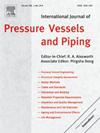典型压力容器CrMo钢的小冲孔试验、液压胀形试验和单轴拉伸试验的对比研究
IF 3
2区 工程技术
Q2 ENGINEERING, MECHANICAL
International Journal of Pressure Vessels and Piping
Pub Date : 2025-05-21
DOI:10.1016/j.ijpvp.2025.105563
引用次数: 0
摘要
当试样尺寸有限时,小试样测试方法为材料的机械性能提供了有价值的见解。各种小样本方法已经应用,但他们的差异和相关性知之甚少。本研究对典型压力容器CrMo钢进行了小冲孔试验(SPT)、水力膨胀试验(HBT)和单轴拉伸试验(UTT),重点研究了应变分布、应力状态和断裂机理。SPT呈“M”形应变分布,应变集中在球与试样接触区域,导致在近双轴拉伸应力状态下发生韧性断裂。HBT呈现倒“V”形应变分布,在双轴拉应力状态下,试样的中心区域发生断裂。基于膜理论,建立了SPT与UTT、HBT与UTT抗拉强度的理论推导相关模型,为SPT与HBT抗拉力学性能预测提供了有效途径。本文的新颖之处在于揭示了SPT、HBT和UTT之间的差异和相关性,并证明了SPT和HBT在材料非常有限的条件下作为UTT机械性能替代测试方法的效率。本文章由计算机程序翻译,如有差异,请以英文原文为准。
Comparison study of small punch test, hydraulic bulge test and uniaxial tensile test for typical pressure vessel CrMo steel
Small specimen testing methods offer valuable insights into the mechanical properties of materials when specimen size is limited. Various small specimen methods have been applied, but their differences and correlations are poorly understood. This study compares small punch test (SPT), hydraulic bulge test (HBT), and uniaxial tensile test (UTT) for the typical pressure vessel CrMo steel, focusing on strain distribution, stress state, and fracture mechanism. The SPT shows an “M” shape strain distribution, with the strain concentrating on the contacting area between ball and specimen, leading to the ductile fracture at the near biaxial tension stress state. The HBT presents the inverted “V” shape strain distribution, with fracture occurring in the central region of specimen at the biaxial tension stress state. Based on membrane theory, the theoretical derived correlation models of SPT and UTT, as well as HBT and UTT, were developed for the tensile strength, providing effective approaches to predict tensile mechanical properties by SPT and HBT. The novelty of this paper is revealing the differences and correlations among SPT, HBT and UTT, and demonstrating the efficiencies of SPT and HBT as alternative testing methods to UTT for mechanical properties in the conditions of very limited materials.
求助全文
通过发布文献求助,成功后即可免费获取论文全文。
去求助
来源期刊
CiteScore
5.30
自引率
13.30%
发文量
208
审稿时长
17 months
期刊介绍:
Pressure vessel engineering technology is of importance in many branches of industry. This journal publishes the latest research results and related information on all its associated aspects, with particular emphasis on the structural integrity assessment, maintenance and life extension of pressurised process engineering plants.
The anticipated coverage of the International Journal of Pressure Vessels and Piping ranges from simple mass-produced pressure vessels to large custom-built vessels and tanks. Pressure vessels technology is a developing field, and contributions on the following topics will therefore be welcome:
• Pressure vessel engineering
• Structural integrity assessment
• Design methods
• Codes and standards
• Fabrication and welding
• Materials properties requirements
• Inspection and quality management
• Maintenance and life extension
• Ageing and environmental effects
• Life management
Of particular importance are papers covering aspects of significant practical application which could lead to major improvements in economy, reliability and useful life. While most accepted papers represent the results of original applied research, critical reviews of topical interest by world-leading experts will also appear from time to time.
International Journal of Pressure Vessels and Piping is indispensable reading for engineering professionals involved in the energy, petrochemicals, process plant, transport, aerospace and related industries; for manufacturers of pressure vessels and ancillary equipment; and for academics pursuing research in these areas.

 求助内容:
求助内容: 应助结果提醒方式:
应助结果提醒方式:


